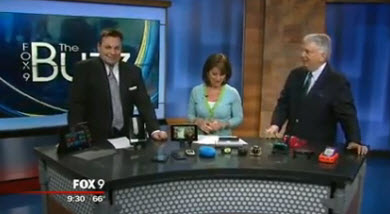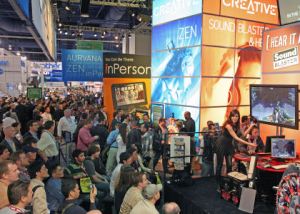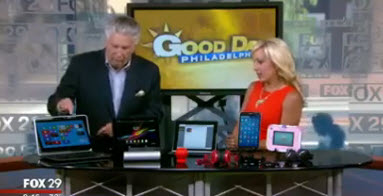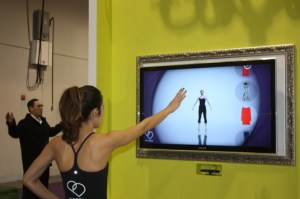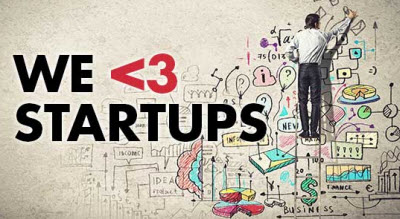Jim Barry is like the old wise man of tech. Every year, he tours the country with his gadgets and encourages people to come to the sprawling tech trade show, International CES, commonly known as the Consumer Electronics Show, every January in Las Vegas.
The Consumer Electronics Association, which puts on CES, calls Barry the Digital Answer Man. The former tech journalist (and current face of the CEA) visits the media with his gadgets and stirs up interest in consumer electronics. I was quite disappointed that he didn’t actually haul a big pile of gadgets in front of me this year, as he said, “You’ve seen all this stuff.” Barry has a good eye for what’s new because he gets to look at a ton of products for a living.
We caught up with him in a recent interview in Silicon Valley. Among the interesting topics: CES will feature more than 200 companies in its Eureka Park startup zone this year, about double its size last year. I enjoyed talking with Barry because he always likes to stroll down the memory lane of technology as he explains the new stuff.
VentureBeat: So you’re getting ready for the next CES. What is catching your attention?
Jim Barry: I’m very struck at how much convergence has actually happened. A quarter of TVs being sold now are smart. It’ll probably be half of them in a couple of years, in households. I’ve been writing about convergence since 1991 when I was at Video magazine. But it’s finally starting to happen. It won’t be long. Wireless HDMI is really important.
VB: Are things like DLNA — the Digital Living Networking Alliance — making convergence happen, or are other things taking root?
Barry: All of these wireless technologies are finally getting to the point where they’re really good. The conventional wisdom used to be, you can have something wired and you’ll get everything up to what the best golden-eared audio guys would like, or if you want to do wireless, yeah, it’s handy, but the quality’s just not there. Now the quality is finally getting there.
VB: It seems like Bluetooth is good for some things, but the wireless HD video part has had to wait.
Barry: Yeah, it has to have more bandwidth. Here’s the thing, though. You can go all the way back to cordless phones. There’s always been that paradigm, that phenomenon. People like not being tied to one place. They like not having cables running all over their house. That’s proven. When the quality gets to the point where the Lucases and the THX guys and all the rest say, “This is good enough for us,” it will be good enough for everyone. That’s coming.
VB: You think that the new game consoles are going to do well. Can you say more about what you think of the new consoles?
Barry: Again, the quality will be there. These are pretty serious computers. And the game makers, the software guys, are promoting software more heavily than I’ve ever seen. I’ve been watching a lot of baseball the last couple of weeks. I don’t ever remember seeing so many ads for video games – for Call of Duty and Grand Theft Auto and all the rest. GTA has other issues, but nevertheless, I think that experience, that immersive experience they’re talking about, is going to spur those sales. As you said before, they can certainly coexist. It’s a different experience playing one of those, compared to playing anything on a handheld device. Absolutely anything.
Another thing I think will help with that is Ultra HD. That’s another immersive experience. You can get right up close to it or sit away from it, and it has a lot of the benefits of 3D without the glasses.
VB: What you said there was interesting. You suggest that marketing really matters in these categories.
Barry: Marketing always matters. It matters in varying degrees. But also, marketing and timing matters. Wireless HDMI has been nascent for a long time. I go back to 12 years ago now, when Apple introduced the iPod. MP3 players had been around for five or six years before that. They had lots of issues, not the least of which were the legalities. But Apple made it very clear that it was cheap, it was legal, and it was easy. Plug it in, you’re done. Then, they overlaid the fashion and lifestyle marketing. And now they still own virtually 100 percent of the MP3 market.
So, back to your question: Marketing is definitely important. Marketing and timing is important. Also, to me, if you want to get something into the mass market, you have to have that ease of use, that simplicity. Even the VCR, which for its entire lifespan was the butt of jokes about how nobody could program it. What everybody could do was get a tape, pop it in, and watch a movie. Many of the features were underutilized, if used at all, but it was easy to use for that. It had a real benefit. Watch whatever you want when you want, providing your video store had it.
Now that ease of use has been taken several steps further forward with Netflix. What’s the number now? On a given evening, Netflix uses 25 percent or 30 percent of the bandwidth on the Internet? Again, there is something that people want. If you want to get really fundamental, people want to learn something, or they want to be entertained, or they want to play a game. Those are fundamental things that all this technology facilitates in different ways, through a lot of different experiences.
VB: I’m curious what you think about the way the new game machines are being marketed. There’s been this discussion in the game industry about how to do this right. Nintendo, with the Wii, captured a lot of nongamers. It failed at that with the Wii U. But now Microsoft and Sony are coming out head-to-head, and Microsoft’s messaging from the start was a lot more like, “This is a broader entertainment system for everyone in the house to use.” It had the voice commands for changing TV channels and things like that. Sony has said, “This is all about games for us.” Sony CEO Kaz Hirai said that unless you get the console into the hands of the hardcore gamers first, the other stuff the box can do won’t get noticed. Their initial marketing is almost entirely targeted at those hardcore gamers, while Microsoft has talked to a broader market from the very beginning.
Barry: This is probably reflective of Microsoft—It goes way back to their desire to control the living room. It’s certainly not by accident that the game consoles, over the previous generation of the Xbox 360 and the PS3, were also streaming video. They were set-top boxes that did other things.
VB: One of the interesting facts is that these two boxes are not so different. Sony’s box will play movies just as well as Microsoft’s will. They’ll both have services for music and TV shows and games.
Barry: The other thing is that those two companies have so many similarities and differences in where they’re coming from. Each of them, you go back 20 years, was the powerhouse in their industry — Microsoft in home computing, Sony in home video and portable audio. They had a march stolen on them in video by a lot of companies, not the least of which were Samsung and Vizio. Microsoft was pushed by Apple and Samsung and everyone else in the mobile space.
Likewise, each of those companies is coming from a place where this part of their business has been a shining light, even as other parts of the business have declined. Microsoft, you know more about their financials, but I’m sure the game sector has done really well. Sony’s game sector has done fine as compared with television and Walkman and other things. They have really nice digital Walkman products. Have you seen their tablet, their Xperia tablet? I’ve showed it to people. It weighs nothing. It’s a beautiful piece. But they’re behind the curve.
VB: Back to CES, what do you think will be interesting as far as the trends there? You already mentioned startups.
Barry: Yeah, Eureka Park is bigger. For your particular beat, that is an interesting and important place. Ultra HD, you’re going to see a lot more of that. Last year, when we were showing it, I don’t think there was anything under $20,000. We’re already talking about some under $1,000 now. Mamas, don’t let your babies get into the television business. That’s why, when people talk about Apple getting into the TV hardware business—We used to talk about it being the place where computer companies went to die. Epson, years ago, showed TVs at CES. There’s just no margin in it now. If anybody could do it, Apple could do it. They could just sell it in their stores, not sell it in Best Buy…
VB: … and sell it for twice what everybody else charges.
Barry: They could. For a while. But they have to buy it from somebody. They’re going to buy it from LG or Samsung or somebody like that, and LG or Samsung will be selling that same product, basically, for half as much money. It’s tough. The other part of it is, if they could make a TV changing channels and doing all this stuff like the apps on an iPad, that would be wonderful. Why can’t they do that? Because they have to deal with all of those service providers and the content providers.
Anyhow, back to trends. All of the lifestyle stuff, the “living in digital times.” Seniors, the Silvers Summit. The mommy tech. The health and fitness stuff. Wearables. Everybody focuses on two things. They focus on the Samsung Gear and on Google Glass. Both of those are very cool and do a lot of neat things. But the place where people are already using lots of wearable technology is the health and fitness space. The monitors and all the rest. We’re going to see a lot more of that.
Another thing is all the auto stuff. The last couple of years, it’s become a huge auto show. We used to call it the car stereo section. Now it’s a literal auto show.
VB: You’re going to get high-speed Internet in your car now.
Barry: Yeah. That brings up all the safety issues. CEA is trying to take a lead on that. We have the whole thing with AT&T, the “It Can Wait” campaign on texting while driving. That really is a terrible problem. Then we have all the mobile stuff, especially Bluetooth. You’re going to see Bluetooth speakers out the wazoo.
3D printing is going to be big. The one that MakerBot was showing last year was a $1,500, microwave-oven-sized kind of thing. Prices are coming down quickly on those. Certainly for commercial applications – any designer or architecture or artist will be using those things.
VB: Intel has gotten into the scene with their do it yourself robots now. This whole DIY hardware movement seems like it’s getting legs. The Maker Faires are getting to be very popular. What do you guys think of that? Do you see any sign of that among CES exhibitors?
Barry: The sign of it would be the different 3D printers and such. That could be the kind of advance guard. There will always be a DIY aspect to almost any business, but at the same time, it’ll be a niche — and I’m not sure how big a niche – in a much bigger market of people who prefer to have someone else do it for them. That’s true of everything from gardening to stereos, going back to Heathkits.
VB: So the way to make that bigger is to make DIY easier to do?
Barry: Yeah. Part of it has to be easier. But DIY is a little different. Certain people feel like the harder it is, the more fun it is. It’s not for everybody. But it grows at the same time the “let somebody else do it” part of the business grows, in concert with that effect.
VB: Where do you see some disruption that’s going to happen? I’ve been very curious about how Android going into the living room is going to disrupt a lot of things, like the Android micro game consoles disrupting the big consoles. That hasn’t quite happened. I keep expecting someone like Apple or Google or Amazon to go and do this to Microsoft and Sony. Do you see some disruption like that?
Barry: One of the reasons they haven’t done that, that would be a whole new cohort of developers they’d have to deal with. They have their hands full with the ones they have. We mentioned Microsoft. Everybody seems to focus on the fact that they missed the mobile space. They’re having a hard time protecting their flank just in operating systems, against the Chromebook and all the rest of that. Google’s been making inroads. There was a newspaper in here recently where the whole paper had switched from Windows to Chrome OS. My wife’s school in the town I live in has made that switch.
VB: There’s Google Docs, too.
Barry: Google Docs is great. We have people all over in different locations who can jump on and change things. That’s another thing. You’re going to have a bit of a Wild West in the living room, because you have the game consoles looking for that control – Microsoft a little more overtly than Sony. Then you have all the cable companies. You have people like Apple and Google. Google’s trying Google TV and all this other stuff. Again, this is where my timing thing comes in. That may have been too early.
But the technology is getting there for all these things, especially the wireless technology, and the commercial aspects of this, the relationships between the carriers and the delivery systems. The cables and the satellites and the phone companies are still sorting through that. They’re trying to defend themselves, these entrenched businesses. I say “entrenched” – small-dish satellite is only 20 years old. Cable is really widely distributed, but it’s only 30-35 years old.
These are industries which are dominant now, but are still relatively new, and they’re trying to maintain their control over the delivery of entertainment and information. Notwithstanding the fact that a lot of young folks aren’t getting cable. They get everything they need through the internet. They still want a big TV, but they’re finding other ways to deliver stuff to that.
VB: Do you have an observation about the troubles between content owners and hardware companies? We seem to be seeing more of those conflicts.
Barry: It’s always been there. If you want to see disruptive, look at things like Aereo. In many ways, though, they’re not as stark as they were in the days of the late ‘70s and early ‘80s, up to the Betamax case. You had movie companies and device companies, VCR makers. The Betamax case was Sony versus Universal Studios. Now Sony is a studio. Comcast owns NBC. So you have delivery and you have content. But then you have somebody like Aereo coming along. It’s a matter of, adapt and move forward or get out of the way.
If you don’t look forward at the ways people are accessing this content and the ways it can be delivered, harnessing the technology—You go all the way back 20 years to when you first had Netscape and AOL and it became easy to get on the internet. It still echoes now, this idea that everything should be free on the internet. Things of value, you’ll always be able to attach a price to it. But in the digital world, it’s a question of how you make that transaction. We’ve already had lots of successful inventions and developments over the last 20 years as far as ways to do that — Paypal and Google Checkout and the like. Some of them have been more successful than others.
It’s about things that make the things people want to do easier, more cost efficient, and more accessible. Watching movies whenever you want, watching the ballgame. Going back 25 or 30 years, it was very restrictive. You couldn’t find some things that you wanted to do. Now you can. The people who can deliver that will be the winners.
Then you have other things that people hadn’t ever thought of. Twitter is a great example. It varies from the sublime to the ridiculous.
VB: The CEA has announced Intel CEO Brian Krzanich as a keynote speaker. They said they were going to move into the Internet of things. Is there anything interesting to say about these guys leading off the show?
Barry: That’s one other thing I didn’t mention that is growing, this internet of things. One of the other keynoters is Rupert Stadler from Audi, which represents the increased prominence of the auto industry. But on the internet of things, part of it is related to what I mentioned earlier, the health and fitness area. Blood pressure monitors that you plug right into your iPhone and either record your information or send it to your doc if you’re on some kind of program.
You’ve seen all the predictions, that by 2020 everything will be connected to the internet, including us. As the chips get smaller and you can put them in more things, finding products and devices and services that will resonate is a bigger challenge. Samsung’s Galaxy Gear, for instance, that’s a cool idea, but it also can be viewed as a very expensive accessory item for a smartphone. It has some uses, but it’s not for everybody. Wearable electronics, though, are being used more widely in fitness now than in any other area.
VB: Have you been playing with any fun gadgets?
Barry: The most fun I’ve had with a gadget lately is one called the Sound Pop. It’s about the size of a tennis ball. It comes in nice colors. I had an orange one. It has a suction cup on it, it’s water resistant, and it’s a Bluetooth speaker. It plays music from your phone. It sounds great. You can put it in your shower. It costs 30 bucks or something.
That’s one of the least expensive ones. Bose has one now that’s probably $250. Definitive Technology makes really nice speakers. JBL, all of these companies now are making Bluetooth speakers. Some of them are really good, with something like a docking station, a little slot you can fit your iPad in.
Casio has one of these G-Shock watches out for over a year that can also sync with an iPhone. You can check and see who’s calling and that kind of thing. There’s a lot of activity in that space. Casio, six or eight years ago, had a camera wristwatch. We’ve had wristwatch cell phones. Those were much too big. But this wristwatch space, I think, a lot of it is too aspirational for it to be a huge market.
VentureBeat's mission is to be a digital town square for technical decision-makers to gain knowledge about transformative enterprise technology and transact. Learn More

